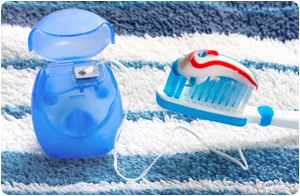Brushing & Flossing with Braces
 Brushing and flossing your teeth and braces properly is important to your oral hygiene — but you are probably wondering the best way to do that. Let’s begin with your essential brushing tool. Either a soft-bristle brush or a bi-level brush (one with shorter bristles in the middle and longer bristles at the edges) is the most effective. Used carefully, your electric toothbrush can work just as well. However, make sure your electric brush is set to a moderate or low power level, and don’t let its vibrations cause the back of the brush head to hit your brackets or braces!
Brushing and flossing your teeth and braces properly is important to your oral hygiene — but you are probably wondering the best way to do that. Let’s begin with your essential brushing tool. Either a soft-bristle brush or a bi-level brush (one with shorter bristles in the middle and longer bristles at the edges) is the most effective. Used carefully, your electric toothbrush can work just as well. However, make sure your electric brush is set to a moderate or low power level, and don’t let its vibrations cause the back of the brush head to hit your brackets or braces!
Brushing
Besides regular brushing with fluoride toothpaste for at least two minutes, you may encounter trouble cleaning the areas near and around brackets and wires. Some special tools can help! One option is the interdental toothbrush or proxabrush. It has a small tuft of bristles that encase a flexible wire, much like a pipe cleaner. Use it gently and carefully to clean the narrow spaces under your wires and around your bands and brackets.
Another option for getting the hard-to-reach places is the oral irrigator or “water pick.” This device shoots a small stream of pressurized water, which can help dislodge bits of food that become trapped in nearly impossible to reach spots in and around the brackets. While it’s easy to use, an oral irrigator isn’t a substitute for a toothbrush or dental floss, but it is effective when used in conjunction with proper brushing and flossing techniques.
Flossing
Flossing is crucial in maintaining healthy gums and a healthy smile with braces. To keep your teeth and gums clean and healthy, you need to floss at least once per day and potentially twice per day if your teeth are crowded. You may be wondering how you get floss under the archwire of your braces. It’s not too hard with the help of a small floss threader. Using this device is somewhat like threading a needle. You pull one end of floss through the threader and then push the threader — carrying with it a free end of the floss — under the archwire. Wrap each free end of floss around your fingers, and slide the floss gently between every tooth and all the way under the gums. Repeat for each section in your mouth until complete.
Brushing & Flossing with Invisalign
One major advantage of the Invisalign and Invisalign Teen systems is that your trays can be removed for easy cleaning. Please don’t neglect to do this! You’ll need to brush your teeth and trays after every meal or snack so that food and plaque do not get trapped in the aligners, which could promote tooth decay and gum disease.
Also, please keep in mind that while wearing clear aligners is very different from wearing braces, the importance of retaining your post-treatment results is exactly the same.
Taking Care of Invisalign Aligners and Clear Retainers
Brush with dish soap to prevent cloudiness, and we recommend you have a second toothbrush for dish soap use. Aligners and retainers should not be boiled or bleached – instead, use effervescent tablets or Retainer Brite to refresh them.

